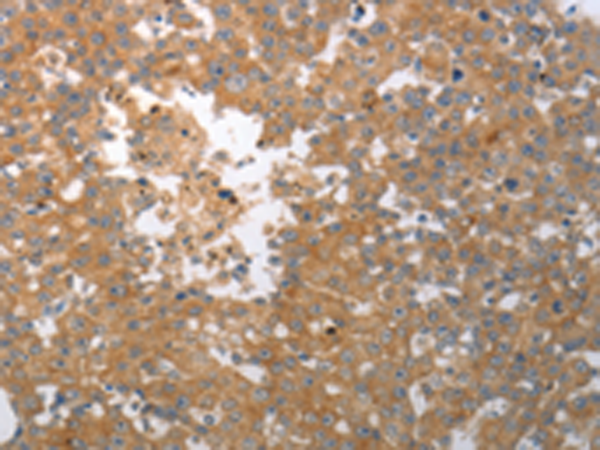Sonic Hedgehog (SHH) Rabbit Polyclonal Antibody
Other products for "SHH"
Specifications
| Product Data | |
| Applications | IHC |
| Recommended Dilution | IHC: 50-100 Positive control: Human breast cancer Predicted cell location: Cytoplasm, ExtraCellular space |
| Reactivities | Human, Mouse, Rat |
| Host | Rabbit |
| Isotype | IgG |
| Clonality | Polyclonal |
| Immunogen | Synthetic peptide corresponding to a region derived from 448-462 amino acids of Human sonic hedgehog |
| Formulation | PBS pH7.3, 0.05% NaN3, 50% glycerol |
| Concentration | lot specific |
| Purification | Antigen affinity purification |
| Conjugation | Unconjugated |
| Storage | Store at -20°C as received. |
| Stability | Stable for 12 months from date of receipt. |
| Gene Name | sonic hedgehog |
| Database Link | |
| Background | This gene encodes a protein that is instrumental in patterning the early embryo. It has been implicated as the key inductive signal in patterning of the ventral neural tube; the anterior-posterior limb axis; and the ventral somites. Of three human proteins showing sequence and functional similarity to the sonic hedgehog protein of Drosophila; this protein is the most similar. The protein is made as a precursor that is autocatalytically cleaved; the N-terminal portion is soluble and contains the signalling activity while the C-terminal portion is involved in precursor processing. More importantly; the C-terminal product covalently attaches a cholesterol moiety to the N-terminal product; restricting the N-terminal product to the cell surface and preventing it from freely diffusing throughout the developing embryo. Defects in this protein or in its signalling pathway are a cause of holoprosencephaly (HPE); a disorder in which the developing forebrain fails to correctly separate into right and left hemispheres. HPE is manifested by facial deformities. It is also thought that mutations in this gene or in its signalling pathway may be responsible for VACTERL syndrome; which is characterized by vertebral defects; anal atresia; tracheoesophageal fistula with esophageal atresia; radial and renal dysplasia; cardiac anomalies; and limb abnormalities. Additionally; mutations in a long range enhancer located approximately 1 megabase upstream of this gene disrupt limb patterning and can result in preaxial polydactyly. |
| Synonyms | HHG1; HLP3; HPE3; MCOPCB5; SMMCI; TPT; TPTPS |
| Reference Data | |
| Protein Families | Druggable Genome, ES Cell Differentiation/IPS, Secreted Protein, Transmembrane |
| Protein Pathways | Basal cell carcinoma, Hedgehog signaling pathway, Pathways in cancer |
Documents
| Product Manuals |
| FAQs |
{0} Product Review(s)
0 Product Review(s)
Submit review
Be the first one to submit a review
Product Citations
*Delivery time may vary from web posted schedule. Occasional delays may occur due to unforeseen
complexities in the preparation of your product. International customers may expect an additional 1-2 weeks
in shipping.






























































































































































































































































 Germany
Germany
 Japan
Japan
 United Kingdom
United Kingdom
 China
China






